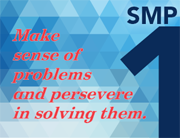Charter Schools Newsletter April 2016
In this Issue
Make Sense of Problems and Persevere in Solving Them
By Sue O’Connell (@SueOConnellMath), author of Putting the Practices Into Action.
Originally posted as part of a blog series on The Standards for Mathematical Practice on Heinemann.com.
It seems ironic that the first Standard for Mathematical Practice focuses on problem solving. When I was a student, math problem solving seemed to be an afterthought. Problems were at the bottom of the textbook page or at the end of a lesson. My perception was that math was about computation. Most of my time was spent memorizing facts and algorithms and solving for the right answer. Thank goodness, then, that we have revised our goals for today’s students. While I do hope they can find the answers to math computations, I know they can accomplish so much more. With guidance from the Common Core Standards for Mathematical Practice, we focus on ways to help our students develop the skills needed to be proficient mathematicians who solve problems.
But how do you teach someone to be a problem solver? That is a particular challenge for most teachers today who, like me, were assigned problems to solve but not taught to be problem solvers by their own teachers. What can we do differently for our students? As we explore the expectations in Practice Standard #1, we gain insights into the complexity of the task. Are we considering process, strategies, and attitudes as we explore ways to teach our students to solve problems?
- Process: Do students understand the process for solving problems? What do they do first? Next? How should they approach and move through a problem-solving task?
- Strategies: Do students have a repertoire of strategies to solve different types of problems? Do they understand when to add, subtract, multiply, and divide? Do they have other strategies to rely on like drawing diagrams or organizing data to look for patterns that might lead them to solutions? Are they able to choose and adjust strategies as needed?
- Attitudes: Do they believe they can solve problems? Do they persevere when problems are complex? Do they have patience when a first approach doesn’t work?
While the teaching of problem solving is complex, there are many steps we can take to foster our students’ problem-solving skills.
- Integrate problem solving with computations. Begin lessons with a problem-solving task. Whether students are adding single-digit numbers, subtracting multi-digit numbers, multiplying fractions, or dividing decimals, the problem context helps students make sense of the computations that follow. The problem gives a context for the operations and helps students better understand when and why we use each operation. In this way, we are simultaneously teaching computations through problems and giving our students experience solving problems.
- Start with comprehension. Focus on first understanding the problem, then solving it. Ask students to retell the problem. Do they understand what is happening? Can they tell you the critical data? Can they justify why a particular operation would make sense for solving this problem?
- Encourage students to visualize the problem. One part of comprehension is the ability to visualize the situation. Can students draw a diagram or show the problem using manipulatives?
- Focus on building a strong understanding of operations. Emphasize the action of operations, not the key words. Are we comparing quantities? Are we splitting a total into groups? Are we combining quantities to find a total? Students who understand the action of each operation, through experiences with many contexts that show that action, are better able to select the operation—and build the equation—that makes sense for a given problem.
- Ask deep questions. Ask students to defend their choice of operations. Ask students to justify the data they choose to use or not use. Ask students to find other ways to solve the problem or to critique the methods of others. Ask students to explain their methods and prove the reasonableness of their answers. Pose questions that prompt students to talk about their thinking.
- Get students talking to one another. Set up opportunities for students to discuss the problem, from the initial interpretation of the task through to the final presentation of their method and solution. Have students debate their methods for both accuracy and efficiency.
- Pose problems that encourage perseverance. Pose problems with multiple steps or with multiple answers. Discuss ways students may have gotten “stuck” when solving a problem and how they got “unstuck.” Praise patience, reflection, and perseverance.
Problem solving is the starting point and ending point in meaningful math instruction. By beginning with problems, we set a context for the math skills students learn, and as students are able to apply varied math skills to solve problems they demonstrate their ability to use and apply mathematics. As our students make sense of problems and persevere in solving them, they are doing the work of a mathematician.
Sue O’Connell is a nationally known speaker and education consultant who directs Quality Teacher Development. She is the coauthor of Putting the Practices Into Action and the Mastering the Basic Math Facts series. Her newest curricular resource, Math in Practice, will be available in early summer. Follow her on Twitter® @SueOConnellMath. |
|
Student Engagement Tip from a Charter School Educator
Jamin B. from Thomas Edison Charter School, Nibley, UT
Jamin writes:
I feel like one of the best ways we can keep students engaged for the rest of the school year is to help them remember why they are coming to school. I love to meet with our students and discuss their plans for their future and how their grades can play into those plans. We talk about scholarships and what they need to be doing now so they can make it to where they are wanting to be, not just in school but after school as well. It's so important to keep students remembering the "why" for education. If they know there is a reason for what they are doing they are more likely to remain engaged.
|
Join Our Program Overview Webinars
Learn more about some of our most popular HMH® programs and get the opportunity to have your questions answered by one of our Content Specialists. Webinars will provide a basic program overview, and multiple times are available each day.
April 12: GO Math!® (Grades K–5)
April 13: Journeys 2017 (Reading ,Grades K–5)
April 14: Collections 2017 (ELA, Grades 6–12)
April 19: Math in Focus® (Grades K–5)
April 26: Escalate English™ (ELL, Grades 4–8)
April 27: HMH World Languages (Grades 6–12)
April 28: ScienceFusion (Grades K–5)
View available times and register.
|
Professional Learning Corner
From The Teacher Tip, a free app from Heinemann
Adapted from Amplify by Katie Muhtaris and Kristin Ziemke.
We use a variety of simple-to-access, digital collaborative spaces to gather feedback from students, respond to student work, or provide information and site links. Like corkboards, chart paper, and sticky notes that make thinking visible, these digital collaborative spaces invite all students to view, respond, and interact.
Try this:
- If you have only a few devices, set up your digital board and leave it displayed and ready. Have students visit during the workshop to share their thinking about a current read-aloud or how they applied the day’s mini-lesson. This is a great way to engage them in reflection and works as a formative assessment piece for you.
- Set up a number of walls by genre or category. Students can leave book reviews on the appropriate wall, as well as get suggestions for books to read. Padlet walls support images, 23 videos, and links. You can also generate QR codes that can be scanned on devices and which will take students directly to the site.
There are other good tools available, but Padlet is excellent because it has a number of options, is accessible from numerous devices, provides a personalized URL, and saves all bulletin boards in a single account. It’s a wonderful tool for gathering feedback from students; teachers use it to pull together final thoughts about a lesson or to share lingering questions. It’s quick to set up and easy for students to access and thus the perfect tool for impromptu lessons and data collection.
Muhtaris, Katie and Kristin Ziemke. 2015. Amplify: Digital Teaching and Learning in the K–6 Classroom.
|
In the News
Students show improvement using GO Math!
According to a recent study published by the Harvard University Center for Education Policy Research, GO Math!® is the only program reviewed to show a statistically significant impact on student achievement on new math assessments.
The program also provides teachers with in-depth instructional support, embedded professional development videos and tips, and a wealth of differentiated instruction resources to ensure the depth of instruction required for student success.
Learn more... |
Financial Resources to Help Your School Excel
Featured Grant—Schools in Service Training Grants from National Council of Teachers of Mathematics (NCTM®)
The purpose of this grant is to provide financial assistance to elementary schools for in-service education in mathematics. Proposals must address the following: need, mathematics content, scope of the plan, other contributing sources of funding, number of teachers and students affected, distribution of costs, urban-rural isolation, and multi-ethnic student body.
Average Amount: $4,000
Deadline to Apply: May 6, 2016
Apply now!
Find more grants with the Free HMH Grant Database.
|
Seeking Curiosity Seekers
We founded the HMH Curiosity Community on the idea that quality content supported by good communication and intelligent discussion can enrich our understanding of our selves and our world. Membership is free and you can choose to participate in our webinars as often as you like. It all depends on what interests you.
Join Us
|
Upcoming Events
Visit HMH at these upcoming events!
4/21: Cisco/HMH Tech Event—St. Petersburg, FL
4/27: Detroit Charter School Leadership Summit—Detroit, MI
5/25: New Jersey Charter Conference—Atlantic City, NJ |
|
NCTM® is a registered trademark of the National Council of Teachers of Mathematics. Houghton Mifflin Harcourt™, HMH®, GO Math!®, and Escalate English™ are trademarks or registered trademarks of Houghton Mifflin Harcourt. Twitter® is a registered trademark of Twitter, Inc. Math in Focus® is a registered trademark of Times Publishing Limited. |











